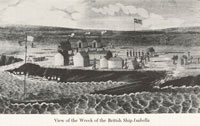 |
The Isabella was a travelling from Australia to England having eventually left New South Wales on 4th December 1812 with a cargo of seal skins, whale oil, pearl shells, sheep skins and ox hides. She also had on board thirty eight passengers, an interesting and dubious group of people from different social scales, including a Captain and Mrs Duries (pregnant) and fourteen marines. The crew numbered fourteen. It was reported that the' vessel was exceedingly ill-provided, both as to rigging and crew. The Captain and Mate were lazy and drunkards; the ship was overloaded, the passengers and crew, exclusive of livestock, amounting to fifty two'.
Isabella was captained by Captain George Highton who was reluctant to leave port. One individual reported “I cannot prevail on Captain Highton to get himself ready for sea although he has everything on board; he has unfortunately formed improper connections amongst the females here and instead of attending to his duty and clearing the ship through the different offices, is drinking and idling his time away about the town”. A passenger however, Mrs Mary Rendall 'quickly bedded down' with Captain Highton on the voyage. Also amongst the passengers was a Captain Richard Brooks said to be a mariner of great skill and experience. He tried to advise and guide Captain Highton who spent much of his time below with his men smoking. A call at the Falklands was necessary to take on fresh produce on the long journey. On 8th February 1813 the islands were sighted. Passing up the east side of the Falklands on Brooks' advice (Brooks seeming to be in charge of the crew at this point) Brooks retired to put on extra clothing. At this point the ship struck upon a sunken rock with dreadful force. The Isabella had grounded on Eagle (Speedwell) Island.
One passenger Sir Henry Browne Hayes, and four others got a boat in the water and taking three of the ships only four oars went off ashore saving themselves. Later as the ship went further ashore another boat managed to get ashore with provisions using the remaining one oar and some souvenir paddles a passenger had acquired.
Back on the Isabella amid the confusion and chaos Mrs Duries, near her confinement, was calm and supported herself with great fortitude. The sailors and marines were drunk and useless due to 'having got hold of the spirits'. The women and provisions were landed. Huts were built, one for the Duries where Mrs Duries later confined. Some of the party left in the long boat navigated by Captain Brooks and eventually reached the River plate and Buenos Aires. On Eagle /Speedwell the Isabella broke up in a storm.
At this time there were many American sealers operating in the Falklands. Captain Charles Barnard of the brig Nania happened to be at Fox Bay sealing and noticed smoke arising from Eagle island. Investigating he found the Isabella's survivors, almost fifty people including women and children. They were overjoyed to see him. Although Britain was then at war with the U.S.A. Barnard offered to take them all to South America or the U.S.A. It was now June and Captain Barnard took the Nania to New Island to wait for the weather to moderate for their departure. On 10th of June Barnard and four volunteers went to Beaver Island to hunt for wild pigs. Returning to New Island harbour they found the Nania gone, taken by the survivors. Barnard and the four men were left with just the clothes they stood in and no provisions to spend nearly two years as castaways on New Island.
Back to Speedwell IslandBack to Disasters and ResucesBack to Wrecks list
|
Sources: Marooned- Captain Charles H Barnard, Edited with an Introduction by Bertha S Dodge